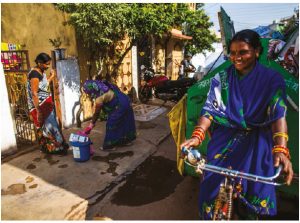
Along with India’s varied culture and diversity, there’s also an overwhelming reality — a distinct lack of basics such as clean water to drink, accessible toilets and good hygiene practices. Compounding that is the country’s tremendous population of more than 1.3 billion people, or 17.7 per cent of the world’s total population.
As I travel to some of the most remote rural communities and navigate the lanes of urban slum dwellings in fast-growing towns, I see this blatant reality everywhere. Yet even though the growing population and the lack of basic resources present an unimaginable daily struggle, there are individuals and indeed entire communities of people who are rising to the challenge.
Having operated in India for the past 32 years, WaterAid recognizes that informed and active communities committed to creating change in their own lives are at the very heart of sustainable development. We see our role as being one of catalyst and enabler. Working alongside communities, we help them secure lasting clean water supplies and decent toilets, thereby alleviating daily hardships and helping to unleash the full measure of their inhabitants’ potential.
I’d like to share the story of Meena Paliwal, the sarpanch (elected head of village government) of Bakheda Kurmi village in the Ichawar block of Madhya Pradesh state.
When I spoke with Paliwal, I was struck by her quiet confidence. As one of the very few female sarpanch in her state, she leads initiatives for the betterment and development of her village. A mother of two children, living with her husband and in-laws, she recalls the journey of finding her voice, knowing her mind and mobilizing men, women and children to make their village “open defecation-free” and much more.
“When I first addressed a gathering of more than 100 villagers, I was very scared, Paliwal told me. “I wanted to be sure of what I was going to say and not just come across as a woman leader who is only the face of the panchayat [village council] while the men make all the important decisions. In my village, which is home to more than 1,500 residents, it is not very easy for a woman to raise her voice. During the initial days of my tenure as a sarpanch, I was told to take a back seat and, for the benefit of the village, let my husband deal with all the major issues.

“But I’m glad that my husband and my family did not interfere and supported my decision to take the lead in working for my village,” Paliwal told me. “My first step was to stand up for myself and share my vision. Acceptance from the villagers was definitely a concern, but I never stopped trying. From conducting regular meetings and addressing issues, even under a veil, to working side by side with other local leaders, slowly, but steadily, I have been able to address various issues related to water, sanitation and hygiene.
“When I was first appointed as the sarpanch, more than 60 per cent of the village was defecating in the open — leading to unnecessary illness. Gradually, I began to interact with the villagers, trying to understand why they were resisting something that would better their lives and allow them to live in a clean and healthy environment.
“In this process, two or three people responded positively and paid heed to my concerns and suggestions. It really felt like a huge achievement at that time. It was good to see that with our consistent efforts and regular discussions, the villagers began to think about the ill-effects of open defecation and were open to change. Soon enough, thoughts turned into actions, and through steady efforts, the village became open defecation-free.
“While the government was already working towards the construction of toilets as part of its Swachh Bharat Mission [Clean India Campaign] launched in 2014, WaterAid India and its partners supported us in ensuring usage of the toilets. With the common aim of achieving “open defecation-free” status, the first step was to involve the villagers in whatever we did to help shift the norm.
“We formed women’s groups in the village. They disseminated information on the usage of toilets, engaged in conversations and raised their voices to advocate for change. The women supported the cause by sharing their personal experiences of defecating in the open. When these women themselves spoke about the humiliation, the embarrassment and the everyday threat they faced while defecating in the open, the message was conveyed in a much stronger way and it resonated well with other women and their family members.
“We also began to levy a fine on the villagers who continued to defecate in the open. At the same time, peer leaders — men and women alike — from the village, who wanted to support the cause, were appointed to keep an eye on the defaulters. Last year, after continued efforts, our village attained the [desired] status. Now, we are working towards installing taps in every household so that there is a regular piped water supply. I am also interacting with government bodies and decision-makers to allocate a budget for installing water tanks in the village.
“I am happy to contribute to my village in this way, and also to share my experiences with others. My greatest desire is to equip my village with basic necessities, such as a regular clean water supply, functional toilets and a healthy environment to live in. It is motivating to see that a lot of other villages in the district, as well as other states, are aiming to implement similar practices and initiate change.
“I am fortunate that all my efforts have been acknowledged. It has been very rewarding to be honoured by the chief minister of Madhya Pradesh for my efforts. A few days ago, I also received an invitation by the Uttarakhand government to address six districts and talk about the work done in my village. Such invitations and speeches do not scare me anymore.”
Paliwal’s is one of the few voices that represent a larger change. Folks such as Paliwal become catalysts to the government’s flagship campaign, where approximately 350,000 villages across the country have been declared open defecation-free.
According to the latest independent survey conducted by National Annual Rural Sanitation, 77 per cent of rural households have toilets and more than 93 per cent of rural households that have access to toilets use them. Though the survey clearly demonstrates the progress made by India in terms of providing access to toilets as well as using them, we’re not done yet.
With the combined efforts of government, community leaders and members and partner organizations, WaterAid India reached 1.1 million people with clean water, sanitation and/or hygiene promotion last year. Awareness campaigns and technical support by WaterAid have motivated the communities and local leaders to take ownership of improving the overall water, sanitation and hygiene condition of their areas. A common feature observed in the communities is the will to work together as one entity towards a common goal. We need to continue to work hard as a country to ensure sustained use of toilets, thus reaching the desired impact and making clean India a reality.
Ishita Rampal is the content officer for WaterAid India.





